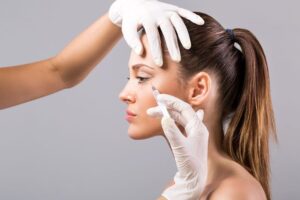Are you suffering from rosacea? You, along with millions of others over the centuries, are not alone, as rosacea is anything but new. The condition was described in The Canterbury Tales in the 1300s and possibly as early as the 200s BC by Theocritus!
Today, in the 21st century, rosacea still affects about 415 million people worldwide, including approximately 1 in 20 people in the UK.
The real questions are: What is rosacea? What causes it? And how can we treat it?
Let’s discuss
Breaking Down Rosacea
Rosacea is a long-lasting skin condition that causes redness, visible blood vessels, and sometimes acne-like breakouts, mainly on the face.
One of the most common signs is persistent facial redness, particularly in the central areas of the face, such as the cheeks, nose, and forehead. Visible blood vessels, or telangiectasia, can also often become prominent on the skin.
Another symptom is the presence of red, inflamed bumps or pustules that resemble acne but are not actually acne. Some individuals may even experience swelling of the face, especially around the cheeks and nose. The skin also can feel dry, rough, or scaly and may be accompanied by a burning or stinging sensation.
Rosacea Triggers
Even after centuries, the exact cause of rosacea still remains unknown, however, several factors are believed to contribute to its development, and they include:
- Genetic Factors: Rosacea often runs in families, suggesting a genetic link. Research indicates that if someone in your family has rosacea, you might be at a higher risk of developing it too.
- Immune System: Some researchers think that rosacea might be caused by an overactive immune system. Environmental factors or bacteria could trigger this inflammation in the skin.
- Environmental Triggers: External factors can make rosacea symptoms worse. Common triggers include sunlight, extreme temperatures, spicy foods, alcohol, and hot drinks. Stress and intense exercise can also cause flare-ups.
- Demodex Mites: Tiny mites are naturally found on everyone’s skin, but there are usually more of them in people with rosacea. These mites may help cause the inflammation and irritation associated with rosacea.
- Helicobacter Pylori: Some studies even suggest that an infection with Helicobacter pylori, a bacteria found in the digestive tract, might be linked to rosacea. However, more research is needed to confirm this connection.
Who Are The Most Commonly Affected By Rosacea?
Rosacea mainly affects adults between 30 and 60 years old, but it can start earlier or later. Women are also more likely to get rosacea, though men often have more severe symptoms.
People with fair skin are at higher risk, likely because the condition is more common in those with lighter skin, and then, last but not least, lifestyle factors and environmental exposures can also increase the risk.
Popular Treatments For Rosacea
While there is currently no cure for rosacea, a range of treatments can help manage and alleviate its symptoms. Treatment plans are usually tailored to individual needs and may include aesthetic treatments, a combination of topical medications, oral medications, and lifestyle modifications.
LED Light Therapy
LED light therapy can be beneficial for treating rosacea due to its ability to address various symptoms and underlying factors of the condition. The therapy helps reduce redness by using red or infrared light to diminish inflammation and vascularity, which can lessen the flushing commonly associated with rosacea.
Additionally, LED light therapy decreases inflammation and calms irritated skin. It also promotes the skin’s natural healing processes and improves overall skin health, potentially reducing the severity and frequency of flare-ups. It also helps strengthen the skin barrier, making it more resilient and less susceptible to environmental triggers that may exacerbate rosacea.
IPL Treatment
IPL stands for Intense Pulsed Light therapy, and this treatment can be highly effective in managing rosacea by addressing several key aspects of the condition. It reduces redness by using broad-spectrum light to target and diminish the dilated blood vessels that cause flushing and redness.
Additionally, IPL helps decrease inflammation, calming the irritated skin often associated with rosacea. Similar to LED light therapy, IPL therapy also makes the skin more resilient to environmental triggers that can worsen rosacea.
Medications
These treatments include antibiotic gels or creams, which are effective in reducing inflammation, bumps, and redness associated with rosacea. They work topically to target the affected areas and alleviate symptoms.
For more moderate to severe cases, oral medications or antibiotics may be prescribed. These systemic treatments help manage rosacea by reducing both inflammation and bacterial load, addressing more extensive or persistent symptoms that topical treatments alone might not fully control.
Lifestyle Modifications
Daily sun protection is crucial for preventing rosacea flare-ups triggered by sun exposure. Applying broad-spectrum sunscreen consistently is essential, and wearing protective clothing, along with avoiding peak sun hours, can further safeguard the skin.
Identifying and avoiding personal triggers, such as spicy foods, alcohol, or extreme temperatures, also plays a significant role in managing rosacea symptoms.
Living With Rosacea
Living with rosacea can be challenging due to its impact on your appearance and potentially your self-esteem. However, with the right treatment plan and lifestyle adjustments, many people with rosacea can manage their symptoms effectively.
In summary, while rosacea is a persistent and often frustrating condition, a variety of treatments are available to help manage its symptoms. Understanding potential causes, identifying personal triggers, and adhering to a comprehensive treatment plan created by a skincare specialist can significantly improve the quality of life for those affected by the condition.











